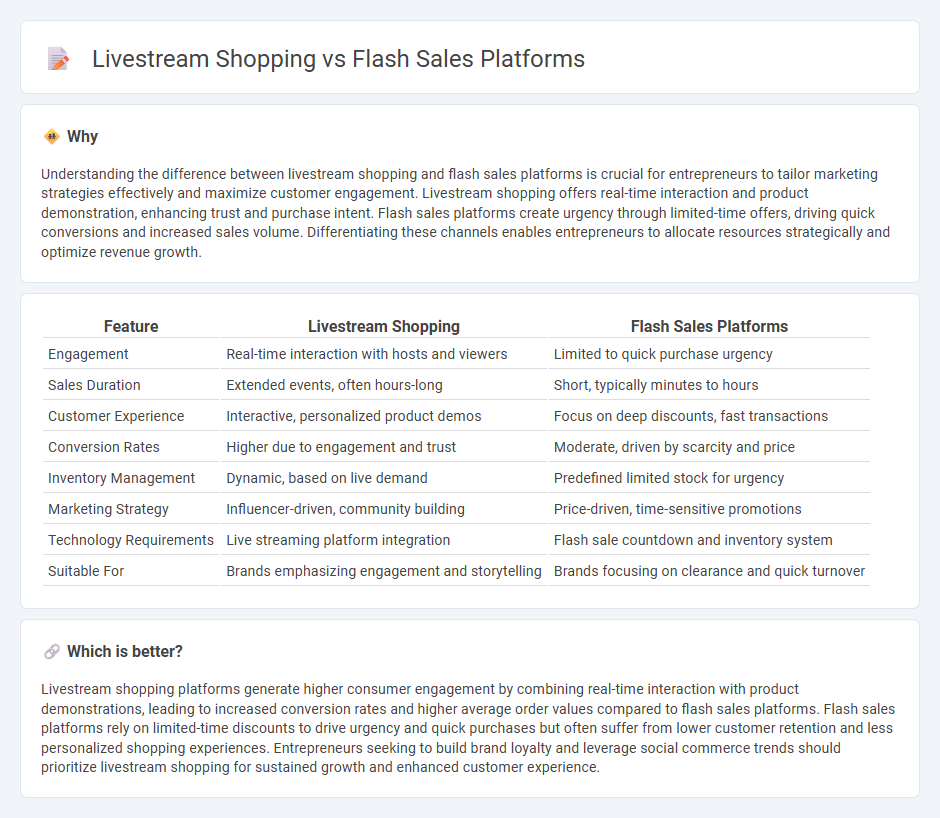
Livestream shopping platforms engage consumers in real-time interactive experiences, driving immediate purchase decisions through authentic product demonstrations and instant feedback. Flash sales platforms create urgency with limited-time discounts, boosting short-term sales by leveraging scarcity and exclusivity. Explore the unique advantages of each platform to optimize your entrepreneurial sales strategies.
Why it is important
Understanding the difference between livestream shopping and flash sales platforms is crucial for entrepreneurs to tailor marketing strategies effectively and maximize customer engagement. Livestream shopping offers real-time interaction and product demonstration, enhancing trust and purchase intent. Flash sales platforms create urgency through limited-time offers, driving quick conversions and increased sales volume. Differentiating these channels enables entrepreneurs to allocate resources strategically and optimize revenue growth.
Comparison Table
| Feature | Livestream Shopping | Flash Sales Platforms |
|---|---|---|
| Engagement | Real-time interaction with hosts and viewers | Limited to quick purchase urgency |
| Sales Duration | Extended events, often hours-long | Short, typically minutes to hours |
| Customer Experience | Interactive, personalized product demos | Focus on deep discounts, fast transactions |
| Conversion Rates | Higher due to engagement and trust | Moderate, driven by scarcity and price |
| Inventory Management | Dynamic, based on live demand | Predefined limited stock for urgency |
| Marketing Strategy | Influencer-driven, community building | Price-driven, time-sensitive promotions |
| Technology Requirements | Live streaming platform integration | Flash sale countdown and inventory system |
| Suitable For | Brands emphasizing engagement and storytelling | Brands focusing on clearance and quick turnover |
Which is better?
Livestream shopping platforms generate higher consumer engagement by combining real-time interaction with product demonstrations, leading to increased conversion rates and higher average order values compared to flash sales platforms. Flash sales platforms rely on limited-time discounts to drive urgency and quick purchases but often suffer from lower customer retention and less personalized shopping experiences. Entrepreneurs seeking to build brand loyalty and leverage social commerce trends should prioritize livestream shopping for sustained growth and enhanced customer experience.
Connection
Livestream shopping leverages real-time interaction to create urgency and drive immediate purchases, making it an effective channel for flash sales platforms. Flash sales capitalize on limited-time offers that boost customer engagement and increase conversion rates during livestream events. Both platforms synergize by combining live product demonstrations with time-sensitive discounts, enhancing sales velocity and customer experience.
Key Terms
Urgency
Flash sales platforms create a high sense of urgency by offering limited-time discounts that encourage immediate purchases. Livestream shopping amplifies urgency through real-time interaction, exclusive deals, and countdowns during live broadcasts, driving spontaneous buying decisions. Discover how integrating urgency tactics in these platforms can boost your sales performance.
Real-time Engagement
Flash sales platforms generate urgency through limited-time offers, driving quick purchases with countdown timers and exclusive deals. Livestream shopping enhances real-time engagement by allowing viewers to interact directly with hosts, ask questions, and receive instant feedback, creating a personalized shopping experience. Explore how real-time engagement transforms consumer behavior in both flash sales and livestream shopping.
Conversion Rate
Flash sales platforms typically drive high conversion rates through urgency, leveraging limited-time offers and countdown timers to prompt immediate purchases. Livestream shopping enhances conversion by combining real-time interaction, authentic product demonstrations, and influencer endorsements to build trust and engagement. Explore detailed data and strategies to maximize your conversion rate in both selling channels.
Source and External Links
What Is A Flash Sale? How to Run One and Examples (2025) - Shopify - A flash sale is a limited-time discount offering to quickly boost revenue and conversions, often promoted via social media and email, with brands like MadebySUNDAY creating VIP experiences by limiting access and creating scarcity to maximize impact.
What are flash sales? - BigCommerce - Flash sales are short-term, heavily discounted promotions with limited quantities designed to drive impulse buying, help move excess or out-of-season inventory, and have helped retailers grow faster by increasing sales velocity.
10 Winning Flash Sale Examples in 2025 - Wiser Notify - Successful flash sale examples include Best Buy's 24-hour sales, Zara's limited-time collections, and Macy's "one day only" sales, which use urgency, timing around holidays, and targeted incentives to attract customers and quickly increase sales.
 dowidth.com
dowidth.com